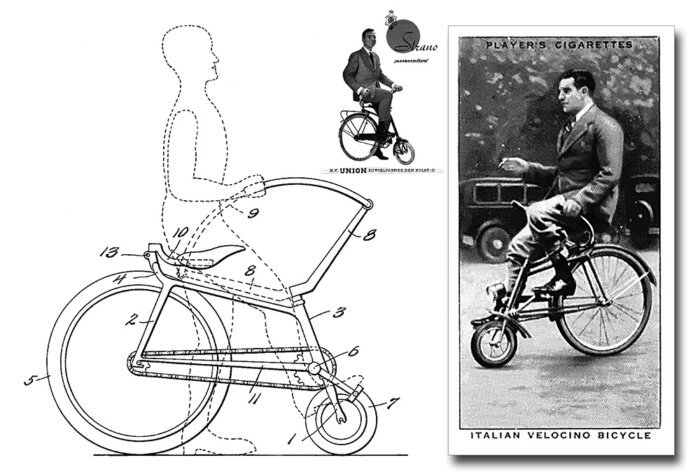

“Subscribe to our service!” “No.”
“Why not?” “…I don’t want to.”
“But you have no viable alternative.” “I don’t care.”
“That… doesn’t make any sense!” “Too bad.”
note
Scene from Seven Psychopaths.


“Subscribe to our service!” “No.”
“Why not?” “…I don’t want to.”
“But you have no viable alternative.” “I don’t care.”
“That… doesn’t make any sense!” “Too bad.”
Scene from Seven Psychopaths.
I was going to say I wanted to see video of it in action, but after search on YT (video was not much more than your picture) in the recommendations I saw the donkey bike (aka velocinno, or velocino?) that looks like a more interesting small (but odd) bike.
Odd because small front wheel (normal back wheel) and optional wraparound-behind-rider handlebars. Both gray footage (and British narration) and also many people chopping 2 bikes together (a child’s bike for the front wheel) to make it.
No idea on how it is to ride (at least inverted behind-rider) though.

EDIT: Seeing video of the non-reverse-mounted handlebars, I’m not sure the claim about changing posture is even true (that’s just about handlebar height, and it seems same either way). I think I’d prefer typical even just for mirror/shifting/bell/etc and mount-dismount (hop-back and tilt-bike-up if-needed).
I mentioned in another comment retro-direct drive, pedalling backwards for the low gear would make something like this even weirder/cooler.
I have a similar feeling for my barely-an-ebike (250w geared folder, ~45lbs, bought on-sale). I sometimes wonder how a non-e bike would compare, it seems like it might be easier so long as I’m half-in-shape (though I don’t have a lot of incentive to ride, so I don’t exactly stay half-in-shape, so I’d probably need a nice stationary bike too).
Wish I could try out a minivelo, probably not much chance of that in USA particularly not for a cheap price. Maybe a folder that’s better-designed than mine (D4S), Brompton is almost a dream (aside from even tinier wheels than 20") except way too expensive. Similarly, a lighter-weight frame like magnesium or titanium would be nice but probably also no.
EDIT: I forgot to say, if I didn’t go with a derailleur a retro-direct drive would be neat. Maybe even cool to make a minivelo with that myself, not that I have really anything required to do so (converting it, maybe). Better if it were somewhat easy to swap gears out (like per-season sort of thing).


do you mind sharing the machine?
Atlas Orthogonal Percussion Instrument*. Basically it pushes the top vertebra back into alignment based on the precise angle needed.
For some background, the cause is I had whiplash many years ago. I also likely have EDS (a potential factor for the low-speed whiplash) so it’s possible even if this machine has some basis it might not be a reliable fix for me.
* often called just the first 2 words


That’s not a contradiction, the fact that it is the page you get from searching the term is exactly their point.
Looking at the page Doctor of Osteopathic Medicine, it even seems to point to both having the same origin (1874 USA) and later changing:
Osteopathic medicine (as defined and regulated in the United States) emerged historically from the quasi-medical practice of osteopathy, but has become a distinct and proper medical profession.
Be it resolved, that the American Osteopathic Association institute a policy, both officially in our publications and individually on a conversational basis, to use the terms osteopathic medicine in place of the word osteopathy and osteopathic physician and surgeon in place of osteopath; the words osteopathy and osteopath being reserved for historical, sentimental, and informal discussions only
Though also…
DO schools provide an additional 300–500 hours in the study of hands-on manual medicine and the body’s musculoskeletal system, which is referred to as osteopathic manipulative medicine (OMM). Osteopathic manipulation is a pseudoscience.
and from the related sources:
Mark Crislip also pointed out that DOs are using less and less osteopathic manipulation in their practice. This is a good thing, and hopefully it will eventually completely fade away. Essentially we need to distinguish between osteopathic medicine, which is mostly equivalent to standard medicine, and osteopathic manipulation, which is pure pseudoscience akin to straight chiropractic.
EDIT: Also it really sucks that things are muddied like this, I have a neck problem and there’s a potential solution that uses a precision machine but I have no idea if it’s a real procedure or just more quackery. I’ve asked a few times and got no responses or just downvotes. Though I also don’t know if the chiro places near me have it or the needed x-ray capability.


A lot of issues like this are how things are designed. Taking a page from NotJustBikes (look them up if you haven’t heard of them), lots of things are car-centric (cities, housing, zoning, parking-lots, lack of public transportation) even when it comes as a detriment to everyone not in a car (and sometimes even those in large vehicles, because congestion).
It’s also another culture-war thing and not even just in the US, look how in Canada Doug Ford wants to remove even the painted bike lane.


I mean… they sometimes are (if the sidewalk is designed for it), look at multi-use trails. A city near me allows bikes (coming from the trail) on wide sidewalks to the main street.
It depends on the flow of pedestrians (too many people would be difficult to navigate with a bicycle anyway) and it can be a visibility issue with doors of storefronts (especially as people leaving likely aren’t expecting/looking-for someone passing on a bike).


It’s a lot less mass and speed (and thus momentum) and it also isn’t a room-sized suit-of-armor that can allow accidentally plowing through the brick wall of a store (unscathed) because they dropped their cellphone between the couch cushions.
Aside from lower lethality for pedestrians than vs cars (especially 30mph+, high hood height trucks, blind spots or malfunctions), a bike rider is at risk to injure themselves in any sort of adverse event (be it flipping over the handlebars, falls/skids, or something like a faulty bicycle frame/fork).


Then again, it’s Top Gear. That might have been one of the guys’ fault. 🤔
TV magic:
The Robin used by Jeremy Clarkson, the Stig and Ken Block had the differential modified to allow the car to roll over more easily. The car also had unequal sized wheels fitted creating an imbalance toward the driver’s side.


I did mean both… Newgrounds is known for animation, too. Have you never seen a flash animation?
The Ultimate Showdown | Everything You Know is Wrong | ~Cyclic~ (Fan animation for Ruler of Everything)
I Like Trains | Don’t Sleep, Robby!
Ruffle adds a bit of overhead to load times, but not too bad.


Also wouldn’t blender be better suited for vertex colored animations?
I make the models in Blender. Animation itself could be done in either, but a mix of the two probably makes more sense (Blender for character animations, in-engine for more dynamic/combined stuff or scenes etc.).
Blender-only would probably be fine if you can export to Blender Game Engine but I’m not sure it’s really a thing anymore. Godot has exports for multiple platforms (also obviously, interactivity). Though anything that could render a scene could work, Raylib or other frameworks/engines.
I feel like in either case the point is lost though since it’ll have to be rasterized eventually.
Not quite. The major point is that it’s being rendered on the user’s computer as-needed rather than the rasterized result being loaded for every pixel on the screen for every frame. The data difference can be huge, particularly as the frames/animations add up.
The most “real” implementation also allows zooming and transformations whereas something like a runtime-rasterized SVG might have ugly pixellation if you do that (haven’t tested Godot’s new SVG oversampling) or even just from bezier conversion with too few points. So I prefer real minimal polygons over rasterized-solution SVGs.
The 3D version of this isn’t even anything exotic. It’s just a 3D game without textures, using old techniques that actually still have some support thanks to being in the 3D formats. It’s an aesthetic choice that is also an optimization.


I miss Flash for vector reasons, both for animations and games. My internet is still slow enough to matter, especially with streaming speed/stability issues.
WebGL is a thing but a bit of a mess, especially downloading. Ruffle or using Wick editor are options… but even Newgrounds doesn’t highlight this (unless you find it first and go to info page from there). I assume most animators just render their animations now.
Have tinkered with vertex color (untextured) models in Godot, I see workflow possibilities there (also for 2D to a lesser extent) but good luck if it’s gotta be me. Some chunk of development is also different from the content it allows.


Does the water give fish arms and legs?
Actually scratch that it don’t matter. How much river water do I have to drink until my pollution stops? Or maybe not if it makes me piss more. Isn’t that pollution? Some kind of sick game you’re pulling here, buster.
That and not going so far that goes past* that point. Even if there would be the slightest benefit**, realism about AI as well as cost (or even hardware need/heat+data of local models) makes it easy to ignore/dismiss.
* depression, isolation, personality disorders etc
** in a way some informational mascot or mental health app may be